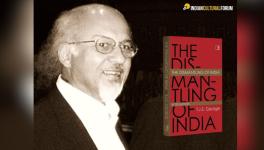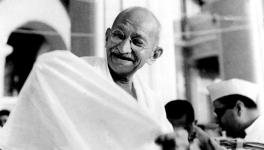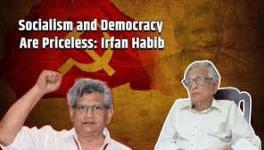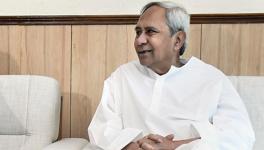Cultural Nationalism and the Left Alternative
Modern Indian politics inherited the intellectual legacy of the Indian Renaissance, which means it forewent the discourse of universal citizenship in favour of a more culturally localised focus on religio-communitarian interests. Indian political class carried out initial interactions with the British not as a modality of citizenship, since the Renaissance had failed to create a non-exclusive imagination of secular identity, but as multiple attempts to build pressure groups that could both bargain with and resist the British authorities. Unavoidably, these pressure groups reflected the actual divisions of Indian society—religion, caste and community.
The entanglement of Indian politics in socio-structural fault lines was visible even in the secular Indian National Congress, whose internal workings were oriented toward striking a balance among the elites of religious entities and denominational communities. Given that Indian politics claimed to represent the sectional interests of communities in relation to the colonial authority, the emerging forms of Indian nationalism were stamped with a cultural character that gave preference to the language of internally homogenous and politically meaningful religious groups.
Aijaz Ahmad talks about how “diverse individuals and groups subscribing to a particular religion or sect came to be defined as coherent communities and political entities precisely because groups of elites needed to claim that they represented such communities and entities.” In colonial society, the discursive predominance of community over citizenship, the invention represented by the representors, translated into a form of anti-colonialism dominated by elite Romanticism. The cultural nationalism of colonised India used revivalist nostalgia and a demand for national re-purification against the British Other, perceived as an agent of defilement that used alien cultural forms to violate the collective India.
In this narrative of past greatness, ahistorical references were made to a Golden Age in which India was a Hindu purity undisturbed by Christian and Muslim incursions. The ruling intelligentsia of a caste-ridden society such as India very frequently confused culture with religion, fueling Brahmanical generalisations of caste cultures as “national” culture. These representation strategies solidified the colonial view of Indian history, which consisted entirely of discrete ages populated by equally well-defined communitarian interests. The Indian nation was posited as an already existing incarnation of an inexhaustible reservoir of shared culture, not a concrete outcome of common citizenship and juridical equality. Nationalism among the anti-colonial leaders remained deeply cultural in its constitution. Its political and civic aspects were overshadowed by the sentiments of blood and belonging, spiritual identity, ethnic or religious essence, revivalism and purification.
Generalising this traditionalising impulse of Indian nationalism, Ahmad notes how “the slide from dreams of cultural retrieval to religious revivalism, and from cultural nationalism to religious purification and particularity, always lurks as a real potential at the very heart of anti-colonial nationalisms of the bourgeois and petty-bourgeois strata.” While the Romantic and anti-progressive imaginary of nationalism confused culture with religion and attempted to valorise India’s historical past to defeat colonial culture, a subaltern thrust towards a materialist conceptualisation of culture also existed. The strategy of Romantic nationalism was to construct an identity between religion and culture throughout society with the help of politically homogenised communities. The strategy of subaltern nationalism was to show how cultural practices included not only religious features and meanings but also social experiences of secular struggles against material exploitation.
Subaltern re-fashioning of nationalism based itself on the modern subjectivity of self-reflexivity instead of eternalising the historical and contingent intertwinement of religion and culture. It sought to critically highlight the internal contradictions that vertically divided the supposedly cohesive communities of religious interests. Against the class elites of religious communities who insisted upon building social identities around primordial loyalties, the Indian subalterns foregrounded the concrete intersection of religious identity with a host of other social and economic vectors, like the existence of class and caste oppressions.
In broader terms, subaltern nationalism advanced a concrete understanding of the Indian social formation, grounded in an analytical perspective for which the history of the people was bound with the history of material production and hence of the classes that constituted those productive structures and its effects. This framework recognised the concrete importance of class struggle, from which flowed the necessity of a multi-cultural and multi-religious community of the oppressed and the replacement of the elite-dominated state by a people-centric democratic community open to all citizens without discrimination. Counterposed to this subaltern materialism was the cultural nationalism of Romanticists, for whom real history was the history of blood, belief, belonging, race, ethnicity, etc. The criteria of truth for any change in society was to be the country’s national ethos, which set its cultural subjects upon the path of divine liberation and constant purification—a permanent circling around the lost zone of a glorious past. What remained central in the minds of cultural nationalists was not the logic of class conflict and social production but the politically manipulated discourses of parochial identities and communities.
Within the Indian anti-colonial struggle, the materialist perspective continued to exist as a subterranean force, calling into question the mainstream language of cultural myths, civilisational clashes, and collective spirit. Such questioning led to radical hostility toward the traditional status quo and generated a very modern conception of every people’s inherent right to liberty, collective self-determination and popular sovereignty. Such anti-colonial social revolutionism produced a culturally diverse, religiously pluralistic, and legally federalist republican nationalism with strong guarantees for individual and collective rights.
Secular nationalism of this modern variety, conscious of the need to displace religion from its place of public importance and install a democratic discourse of universal rights, was perceived by native Romanticists as disruptive to the unity of the anti-colonial movement. A blinkered focus on the struggle for political autonomy through a cultural movement with religious underpinnings was considered more expedient. Consequently, the secular politics of subaltern materialism was replaced by an elite emphasis on a shared culture constituted by religions and castes. As a result, a disjunction emerged between the politically progressive objective of national independence and the culturally regressive goal of nativist rebirth. KM Panikkar writes:
That a large number of people who supported and even participated in political struggles were unable to go along with temple entry or eradication of untouchability was an expression of this. A distinct gap existed between their cultural and political consciousness…at a time when political movement was the dominant force a transformation of backward elements of culture was possible only through an integration with it. As it did not happen, backwardness in culture not only continued to exercise its influence over the popular mind, it also succeeded in dominating it. What happened in India was not an integration of cultural and political struggles but an intrusion of culture into politics. Instead of politics transforming backward culture, politics was vitiated by cultural intrusion. We find this tendency developing, even if unintended, from the time of Bal Gangadhar Tilak’s Ganapati festival and Gandhiji’s Rama Rajya, to assume monstrous proportions in the religion-based politics of the Muslim League and the Hindu Maha Sabha during the national movement.
In Independent India, the weaknesses of the anti-colonial struggle are visible even today in the electoral tactics of liberal secularists, who have allowed the cultural discourse of primordial loyalties to hollow out the modern message of political sovereignty constantly. For them, nationhood is defined in a civilisational manner instead of being a standard product of the anti-colonial struggle. Ahmad writes: “Please contemplate the fact that the claim that we are a nation is, in our history, much older than the claim that we are a secular nation or that this nationhood in some fundamental way cannot be born without the abolition of colonial autocracy. Even the most secular of our nationalists continued to think of India as a primordial nation civilisationally defined, rather than a modern nation that was the product of the anti-colonial movement itself and an entity that arose out of the crucible of 15 August 1947.”
Given that Indian liberals continue to operate primarily on the terrain of culture and civilisation, secular activities in civil society are mostly confined to the highly predictable invocation and idealisation of the uniquely tolerant nature of the Indian religious tradition—a mechanical exercise that arises in response to the communal focus on religious conflicts and extremism. In this entire political operation, what remains constant is the undiminished primacy of religion as a moral and cultural code of political action. Liberal secularists and right-wing fanatics agree on religion as a totalising model of existential ethics, as sufficient as the secular and modern framework of the Indian constitution—a present-day manifestation of the cultural intrusion into national politics during the anti-colonial struggle.
Communists insist on displacing religion from its current status as a social totality and reducing it to a mere subcomponent of a wider democratic discourse of universal values. As Vanaik says:
Religious discourse is not communalist discourse. It only provides the alphabet, or perhaps some words, from which the ugly sentences of communalist discourse are constructed. But religious discourse must also be seen as only one kind of discourse, language or alphabet system, among others, in a modern, secular society. It is a discourse that must recognise its limited applicability. When it intrudes into other domains where other languages (and alphabets) are more fitted—i.e. when it becomes legitimised as an acceptable discourse on the terrain of modern politics—then it widens the field over which communal discourse operates. This is true even when, in that domain, it can be used to fight communal constructions of its ‘alphabet’.
The Communist stance toward religiocisation is visible in the controversy that the Indian Right has created over various historical events. In 1921, the Mappila Muslims of Kerala staged an armed revolt against the British authorities and their feudal allies, who happened to be upper-caste Hindus. Since the landlords and peasants were from different religious groups, the revolts of the Mappila Muslims against their exploiters are regarded as communal riots, as expressions of Muslim fanaticism against the Hindus. The hidden presupposition of this communal angle is that an individual’s personality is wholly determined by a single identity, that of religious faith: “Therefore, a Hindu or a Muslim, whether he is a peasant or a landlord, a worker or an industrialist, a teacher or a bureaucrat, a politician or a scientist, is guided by a consciousness rooted in religion. An implication of this imputed univocal consciousness is that he is a member of a community of such individuals professing the same faith, regardless of the different secular vocations in which they are engaged.”
Instead of revealing the multifarious constitution of the individual, and the historically diverse forces that combine to generate their contradictory consciousness, the Right obscures any form of concrete politics by imposing upon them the grand abstractions of religion. Instead of fighting this increasing religiocisation of society, Indian liberals keep talking about religious co-existence and harmony. The secularism as religious harmony model is based on a unidimensional view of religion, ignoring the differentiations that divide religious communities vertically. Each religion contains within itself multiple social, economic and cultural groups, among whom relationships are not just complementary but also contradictory. Taking into account the fact of intra-religious divisions, homogeneous religious communities don’t exist. Religious categories are historically enmeshed in a network of social and economic relations. Any political position that singularly focuses upon religious pluralism substantivises religion, giving it a solid character it does not possess. The reification of religion, in turn, accentuates the sense of difference that is inherent in any religious identity, creating the religious base upon which communal forces can work.
A Communist approach to secularism, in contrast, would de-institutionalise religion by showing how it is filled with social and cultural hierarchies that prevent the formation of a neat faith-based consensus. This shifts the emphasis from internally unified religious communities to the multiple material and ideological contradictions that sustain religion as a conflictual historical category. Since religion is no longer regarded as a complete totality but as a contingent and contradictory mode of social organisation, the language of homogenous religious communities and the attendant liberal construction of inter-religious harmony becomes redundant. What matters now is the firm guarantee of universal equality that would end all forms of exploitation found in religious groups. The liberal narrative of religious co-existence and toleration no longer occupies a central place because it is superseded by a democratic narrative that transcends religious pluralism to construct an over-arching framework of justice, equality and fraternity.
Within this all-encompassing discourse of modern values, secularism is re-articulated as the universal promise of citizenship, carrying within itself the “values of non-racial and nondenominational equality, the fraternity of the culturally diverse, the supremacy of Reason over Faith, the belief in freedom and progress, the belief that the exercise of critical reason, beyond all tradition or convention or institution, is the fundamental civic virtue without which other civic virtues cannot be sustained”.
India’s current political situation demands a Communist version of secularism that would embed the multi-religious working class in the democratic totality of secular struggles against economic exploitation and political repression. This dialectical transcendence of religious pluralism stands in contrast to liberal anti-communalism, which merely searches national tradition to find instances of religious harmony. Socialist political practice will overcome this anaemic agenda of national integration and communal harmony by waging progressive democratic struggles that include within their programmatic vision the fight of the multi-religious working class against all forms of exploitation, including communal manipulation.
Usually, such a socialist universalism is rarely present in democratic struggles. Therefore, an organic connection between secular action and democratic struggles is not formed. Panikkar notes, “Almost all voluntary organisations engaged in fighting for peoples’ rights are secular in their conviction. Yet, they all tend to remain single-issue-oriented organisations without incorporating a conscious struggle for secularism in their activities. Therefore, in times of crisis, their secular commitment becomes rather fragile, as happened to some trade unions in Mumbai at the time of the Ramajanmabhumi campaign.”
The viewpoint of socialist universalism will remedy the religious exclusivism of democratic struggles through a movement for secularisation dedicated to combatting the exploitative practices of institutionalised religious formations. The Left used to do this before it began eulogising India’s syncretic traditions and interfaith unity. In the past, the Left parties would use the local idiom of folk cultures to criticise piety and blind faith, thus promoting a secularised commitment to pro-poor universalism. In the words of Praful Bidwai, “Left-wing activists in the arts and theatre would deploy satire and parody to demolish the moral claims of devotees of Ram, including the Kshatriya prince’s upholding of customary casteist dogmas and practices such as beheading a Shudra for committing the crime of reading the Vedas, or driving Sita to self-destruction in defence of male-supremacist prejudice. They would pour scorn on religion and self-styled swamis.” Today, we need to construct a left-wing secular discourse that consciously recognises itself as a subset of the discourses of democracy and equality. Such a general democratic discourse oriented toward the principles of socialism would secularise civil society and thus combat the resurgent wave of neo-fascism.
The writer is a student based in Aligarh. The views are personal.
Get the latest reports & analysis with people's perspective on Protests, movements & deep analytical videos, discussions of the current affairs in your Telegram app. Subscribe to NewsClick's Telegram channel & get Real-Time updates on stories, as they get published on our website.
























